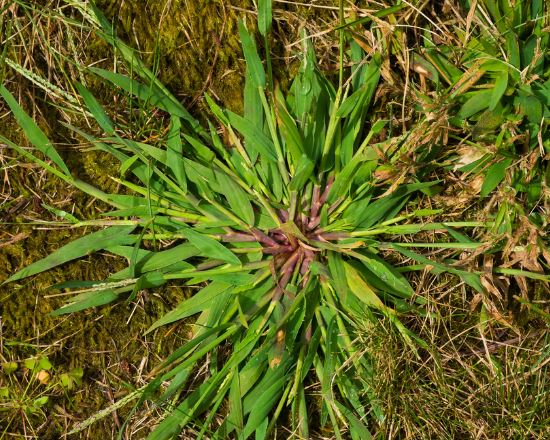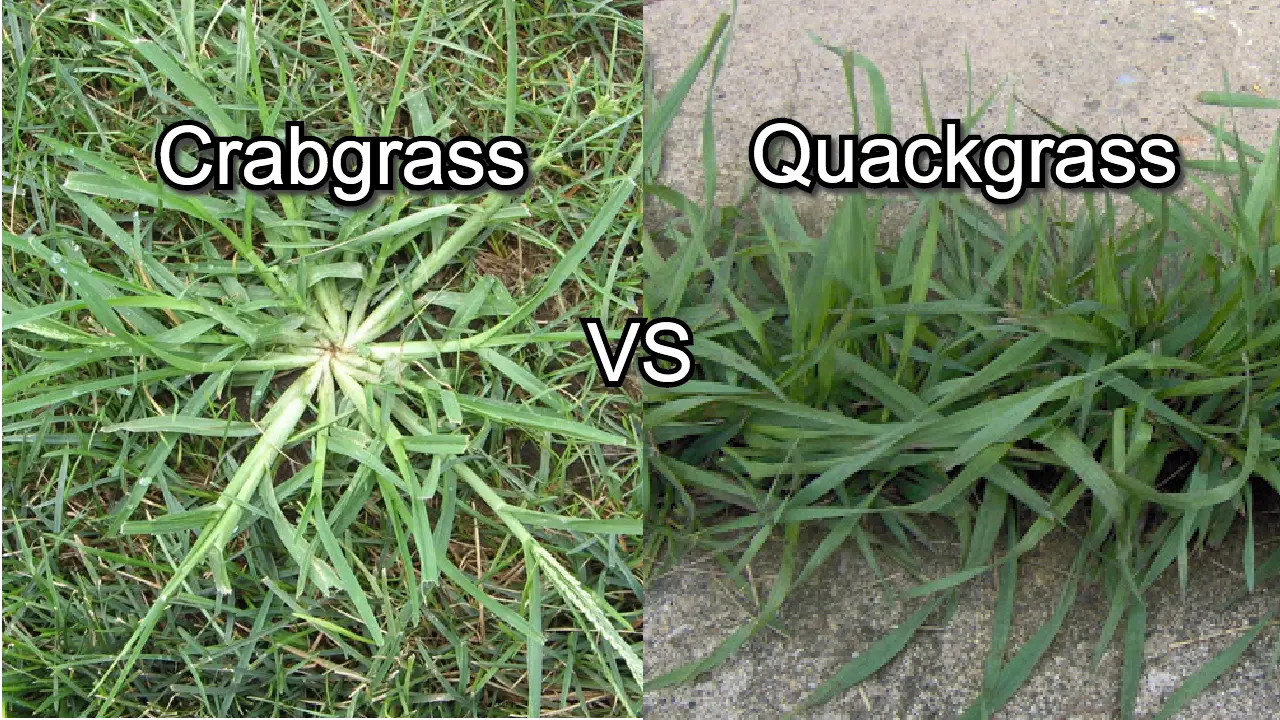Not all lawn weeds are as prominent and obnoxious as dandelions. However, grassy weeds can be detrimental to the overall health of your lawn and its appearance. Two of the most common weeds you may find invading your lawn are crabgrass and quackgrass. Often, these two grassy weeds are confused with one another – so this article will teach you how to identify crabgrass and quackgrass. It will also guide you on how to treat your lawn, from the prevention of crabgrass and quackgrass all the way to removal.
Your biggest hint when wondering which grassy weed your lawn has is your climate. Crabgrass likes heat and is typically a warm climate grass, while quackgrass thrives in cooler climates. You can also identify these grassy weeds based on their roots. Crabgrass is aptly named for its crab-shaped structure: a clump of grass with several shallow roots, like crab legs on the body. Quackgrass grows long, pale roots that travel horizontally while embedding themselves into the soil.
Perhaps the most important difference between crabgrass and quackgrass is their response to herbicides. There are herbicides that selectively kill crabgrass – however, quackgrass will only respond to strong weed killer that is non-selective, and kills anything it touches.
Identifying Crabgrass

Crabgrass, aptly named Digitus in Latin, is known for its finger-like roots that spread outwards from a clump of flat-lying grass. It is a grass variety that is natively tropical but has many varieties, including ones that survive in cooler climates. The root system is completely under the soil and stems from one source. If you aren’t 100% sure that you want to uproot the weed in order to find out if it is in fact crabgrass, it can also be identified by a reddish hue near the bottom of the stem. The blades of grass themselves are thick and flat compared to most regular lawn turfs, and you will notice crabgrass grows in clumps, staying flat to the ground.
Crabgrass thrives in heat, so it is often found growing on the lawn’s edges where the soil meets the pavement. This is where the soil is the warmest and most desirable for crabgrass. Also due to their natural love for heat, you are most likely to find this grassy weed won’t show up until the middle of summer, making it difficult to identify before it becomes a problem.
Identifying Quackgrass

Quackgrass, Latin name Elymus repens, also looks like a thick, flat-bladed grass when compared to regular turf grass. However, its main identifier is how much taller the quackgrass is than the lawn grass. If you are unsure as to whether or not you have quackgrass invading your lawn, try to refrain from mowing for a few days and see if the invading grass grows faster. The color of quackgrass is usually an ashy blue-green. You will notice quackgrass has a very unique way of sprouting new blades when you look closely. Each stem of grass will produce several blades growing outwards that appear to ‘grasp’ onto the stem. The root system itself enables this pesky grass to spread quickly by using rhizomes, which creep across the lawn while establishing connector roots into the soil in order to obtain nutrients.
See this quick video for a visual guide on how to identify different grassy weeds, such as crabgrass and quackgrass.
Comparison Chart: Crabgrass vs Quackgrass
This chart outlines the main differences between crabgrass and quackgrass in terms of appearance, growth, and treatment.
| Crabgrass | Quackgrass | |
| Climate | Warm season | Cool season |
| Roots | Shallow, from one source | Creeping rhizomes |
| Coloring | Lime green, red at the roots | Blue green, pale white roots |
| Appearance | Wide, flat blades | Wide, flat blades |
| Growth habit | Grows in clumps | Grows singular and tall, will spread |
| Hardiness | Perennial | Perennial |
| Treatment | Pre-emergent or herbicide that targets crabgrass | Spot treatment with a non-selective Herbicide |
Now that you have the tools to properly identify the grassy weed that has invaded your lawn, it is time to move on to the most important issue – how to get rid of crabgrass or quackgrass. There is a lot one can do to prevent, control, and kill grassy weeds like crabgrass and quackgrass.
Crabgrass Treatment Guide
Crabgrass Prevention
Preventing weeds is often as simple as keeping a healthy, thick lawn. The denser the grass grows on a lawn, the harder it is for weeds to penetrate. Keep your lawn watered and fertilized in order to help the turf choke out weeds and prevent crabgrass from germinating later in the spring.
Consider landscaping around your yard with trees and shrubs to create shady conditions. Crabgrass loves full sun and heat, so try to inhibit these conditions. Keep your lawn watered during the hot summer months to prevent dormancy. Crabgrass thrives on a dormant lawn.
Crabgrass Control
By simply mowing the lawn a little higher, you give your turf a chance to outgrow existing crabgrass and therefore shade it from the sun. It may be tempting to mow your lawn more often to hid the fact that you have grassy weeds, however, keeping your lawn short will only encourage crabgrass to grow and germinate. Remember to always collect and bag lawn clippings to stop crabgrass from spreading.
Now that you know what crabgrass looks like, use this information to your advantage and spot the weed in its early days. During the first hot days of summer, you can uproot the first patches of visible crabgrass and if you get lucky, that might be all you need to do to control crabgrass on your lawn. Be careful to get the whole root system out of the soil when removing and do so carefully as to not spread any seeds. Dispose of the crabgrass in bags as to not spread the seed elsewhere.
How to Kill Crabgrass
The best way to fight crabgrass is with a pre-emergent herbicide. A pre-emergent that is selective can be formulated to kill crabgrass (before they become visible) without harming your lawn. A great solution is Tenacity Turf Herbicide, which works well as a pre-emergent and a post-emergent. Be careful to apply in spring, and not when the temperature is above 90 degrees.
If you are having issues with not only crabgrass, but dandelions, clover, or other common weeds as well, you may opt for a weed killer that does it all. Consider this special crabgrass formula by Spectracide. It will kill and control most common weeds while leaving your lawn turf intact. Using this method may require you to wait until crabgrass is visible before spraying. Read more about weed killers for lawns here.
Quackgrass Treatment Guide
Quackgrass Prevention
Preventing a hardy, cool-season perennial like quackgrass can be tough. The same rule applies here as it does to crabgrass – quackgrass is easiest to prevent with a healthy, thick lawn. A lawn with a deep root system and blades of turf that grow tightly together will choke out unwanted grasses. Therefore, the best defense against quackgrass is a well-established, thick, healthy lawn.
Quackgrass Control
Just as any other weed, quackgrass can be kept under control if removed from the source straight away. Using a gardening hand shovel, you can dig a patch of quackgrass, and its roots, right out of your lawn. Make sure to dig about a foot down and a foot across, watching out for any spreading rhizomes, and be sure to remove the entire root system. Fill the holes back up and reseed with your lawn grass to cover any holes.
If quackgrass has invaded your lawn completely, there is another way. Albeit a long process involving extra labor, this method will naturally help you choke out the quackgrass over time. Mow your lawn to 3 inches at least weekly, to stop the tall quackgrass from getting ahead fo your lawn grass. Eventually, your lawn will outgrow the quackgrass.
How to Kill Quackgrass
Killing quackgrass is not as simple as crabgrass. Due to its extreme hardiness, quackgrass is resilient against selective herbicides, so there is no chemical treatment that will kill quackgrass while leaving your lawn intact. Consider using a glyphosate weed killer that will eliminate all growth from your lawn, so you can start from scratch and reseed. Be careful to do a thorough job, and repeat the treatment several times over the course of a few weeks – if any trace of quackgrass or its roots are left behind in untreated soil, they will come back. Choose wisely when reseeding. It is possible the invasion was due to the variety of grass on your lawn, so make sure the seed you sow is a hardy one, such as bluegrass or tall fescue.
Alternatively, if you do not want to invest in an entirely new lawn, you can try to kill areas of quackgrass by spot-treating with a weed killer. Be very careful to paint only the leaves of the weed, and avoid getting any herbicide on the plants you do not wish to kill. Some recommend using a weed killer spray shield, in order to isolate the area you would like to treat.
Top Tips for Getting Rid of Both Crabgrass and Quackgrass
- Mow lawn at a higher height than normal – about 3 inches – and always bag clippings to avoid spreading seed
- Overseed a sparse lawn to promote a thick, intimidating environment that is hard for weeds to penetrate
- Fertilize regularly – make sure your lawn turf is getting the nutrients it needs to surpass weeds
We recommend products from companies like Amazon, which we also get a small commission from, to keep this website running. However, we want to stress that all of the products we recommend are tested, used by us, and 100% unbiased and true.

